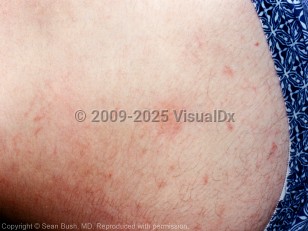Centipede envenomation
Alerts and Notices
Important News & Links
Synopsis

Centipedes are elongated, multisegmented arthropods with 1 pair of legs per body segment. They are found worldwide in warm, temperate, and tropical regions, where they typically live underground. They are nocturnal hunters, preying mostly on invertebrates, and are fast moving.
Centipedes have between 15 and 100 body segments. The first segment bears claws with venom glands at their bases. The venom is primarily used to kill prey and contains a complex mixture of proteins, histamine, and serotonin that is not well studied.
Centipede stings typically cause severe, burning pain, local swelling, redness, pruritus, and lymphadenopathy. Systemic symptoms include nausea, vomiting, headache, palpitations, and anxiety. Hemorrhagic vesicles, ulceration, and local necrosis can occur at the sting site. Death is rare, with only 3 reported cases in the literature. Proteinuria, rhabdomyolysis, a case of myocardial ischemia, and another case of myocardial infarction have also been reported.
Centipedes have between 15 and 100 body segments. The first segment bears claws with venom glands at their bases. The venom is primarily used to kill prey and contains a complex mixture of proteins, histamine, and serotonin that is not well studied.
Centipede stings typically cause severe, burning pain, local swelling, redness, pruritus, and lymphadenopathy. Systemic symptoms include nausea, vomiting, headache, palpitations, and anxiety. Hemorrhagic vesicles, ulceration, and local necrosis can occur at the sting site. Death is rare, with only 3 reported cases in the literature. Proteinuria, rhabdomyolysis, a case of myocardial ischemia, and another case of myocardial infarction have also been reported.
Codes
ICD10CM:
T63.411A – Toxic effect of venom of centipedes and venomous millipedes, accidental, initial encounter
SNOMEDCT:
217677005 – Poisoning due to centipede venom
T63.411A – Toxic effect of venom of centipedes and venomous millipedes, accidental, initial encounter
SNOMEDCT:
217677005 – Poisoning due to centipede venom
Look For
Subscription Required
Diagnostic Pearls
Subscription Required
Differential Diagnosis & Pitfalls

To perform a comparison, select diagnoses from the classic differential
Subscription Required
Best Tests
Subscription Required
Management Pearls
Subscription Required
Therapy
Subscription Required
References
Subscription Required
Last Updated:02/19/2018
 Patient Information for Centipede envenomation
Patient Information for Centipede envenomation
Premium Feature
VisualDx Patient Handouts
Available in the Elite package
- Improve treatment compliance
- Reduce after-hours questions
- Increase patient engagement and satisfaction
- Written in clear, easy-to-understand language. No confusing jargon.
- Available in English and Spanish
- Print out or email directly to your patient
Upgrade Today

Centipede envenomation

